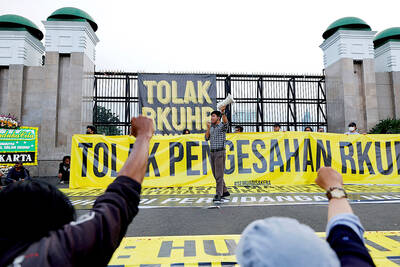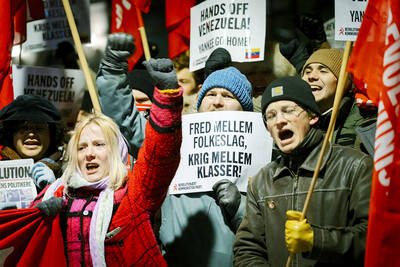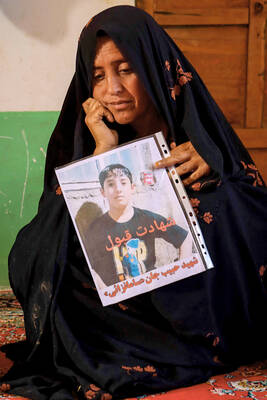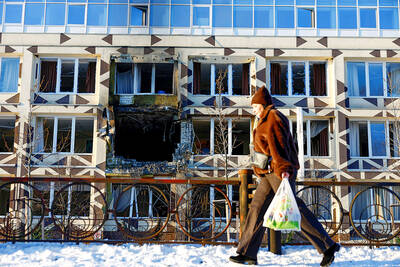In a city gearing up to celebrate the anniversary of its open borders, it is the one place where the door often remains emphatically shut.
Berghain, a Berlin nightclub celebrating its 10th birthday this year, has become notorious not just for the dark industrial techno it serves up from Friday nights until Monday afternoon, nor the sexual fantasies lived out in the “darkrooms” inside this former power plant, but also for its strict and enigmatic door policy.
Web sites and forums promise to spill the secret of how to get past the grim-faced bouncer at what might be the world’s most famous nightclub. Turning up in big groups is said to be a no-no, as is chatting in the queue.
A new “How to get into Berghain” app promises updates on the length of the queue outside the super-secretive venue with the motto “We decide with whom we want to party.”
However, for its anniversary, Berghain is opening its gates to reveal a gentler side. For a start, there is no face control at the art exhibition in one of the industrial halls, which includes paintings, photographs and videos inspired by the venue, historic graffitied toilet doors and an aquarium filled with urine, lit in melancholy hues.
A memoir by the club’s bouncer Sven Marquardt reveals the tattooed and pierced figure as a sensitive soul who used to look for love on the streets as a gay punk in east Berlin.
“Even when I was a punk, my motto was always: Mothers and the elderly first,” Marquardt writes in Die Nacht ist Leben (“The Night is Life”).
At the book’s launch party, the feared Berlin legend claimed that at 52 he was “fast on my way toward age-related mildness.”
Marquardt, who trained as a photographer, started his doorman career at Snax — a Berghain predecessor that had the tag line: “For pervy men only.”
Being a bouncer, his book argues, is all about the “right mix.”
“I don’t mind letting in the odd lawyer in a suit with his Gucci-Prada wife,” he said. “We also take guys in masks and kilts, or Pamela Anderson blondes who tag along with bearded blokes, licking the sweat off each others’ armpits. That, for me, is Berghain.”
This week, broadsheets and online forums have been filled with odes to the “Berlin Philharmonic of electronic music.” Many credit Berghain — a compound of districts Kreuzberg and Friedrichshain — with a key role in reinventing the German capital.
For many of the 3,000 clubbers on a typical night, it is the main reason for coming to the city.
“Berghain has become the ultimate symbol of the ‘new’ Berlin,” said Tobias Rapp, author of Lost and Sound: Berlin, Techno and the Easyjetset. “When I wrote my book in 2009, only people in the techno scene knew about Berghain. Now my father-in-law is begging me to take him there.”
Bouncers such as Marquardt were crucial to protect subcultures like those flourishing at Berghain, Rapp said.
His advice for getting through the door is: “Don’t be afraid. People who are afraid usually aren’t very good at partying.”

Indonesia yesterday began enforcing its newly ratified penal code, replacing a Dutch-era criminal law that had governed the country for more than 80 years and marking a major shift in its legal landscape. Since proclaiming independence in 1945, the Southeast Asian country had continued to operate under a colonial framework widely criticized as outdated and misaligned with Indonesia’s social values. Efforts to revise the code stalled for decades as lawmakers debated how to balance human rights, religious norms and local traditions in the world’s most populous Muslim-majority nation. The 345-page Indonesian Penal Code, known as the KUHP, was passed in 2022. It

‘DISRESPECTFUL’: Katie Miller, the wife of Trump’s most influential adviser, drew ire by posting an image of Greenland in the colors of the US flag, captioning it ‘SOON’ US President Donald Trump on Sunday doubled down on his claim that Greenland should become part of the US, despite calls by the Danish prime minister to stop “threatening” the territory. Washington’s military intervention in Venezuela has reignited fears for Greenland, which Trump has repeatedly said he wants to annex, given its strategic location in the arctic. While aboard Air Force One en route to Washington, Trump reiterated the goal. “We need Greenland from the standpoint of national security, and Denmark is not going to be able to do it,” he said in response to a reporter’s question. “We’ll worry about Greenland in

PERILOUS JOURNEY: Over just a matter of days last month, about 1,600 Afghans who were at risk of perishing due to the cold weather were rescued in the mountains Habibullah set off from his home in western Afghanistan determined to find work in Iran, only for the 15-year-old to freeze to death while walking across the mountainous frontier. “He was forced to go, to bring food for the family,” his mother, Mah Jan, said at her mud home in Ghunjan village. “We have no food to eat, we have no clothes to wear. The house in which I live has no electricity, no water. I have no proper window, nothing to burn for heating,” she added, clutching a photograph of her son. Habibullah was one of at least 18 migrants who died

Russia early yesterday bombarded Ukraine, killing two people in the Kyiv region, authorities said on the eve of a diplomatic summit in France. A nationwide siren was issued just after midnight, while Ukraine’s military said air defenses were operating in several places. In the capital, a private medical facility caught fire as a result of the Russian strikes, killing one person and wounding three others, the State Emergency Service of Kyiv said. It released images of rescuers removing people on stretchers from a gutted building. Another pre-dawn attack on the neighboring city of Fastiv killed one man in his 70s, Kyiv Governor Mykola